Top 10 Backend Frameworks In 2024
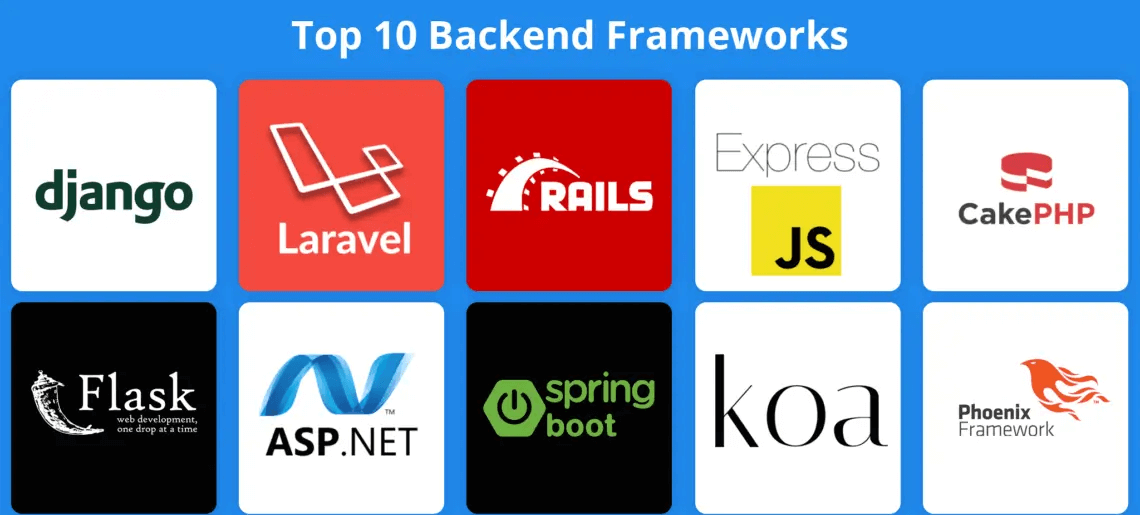
Backend frameworks play a crucial role in web development. Without these frameworks, building and deploying web applications would consume an enormous amount of time and resources, significantly increasing the development process’s complexity.
Backend frameworks provide developers with the necessary tools and support to handle mundane tasks like server configuration, database management, and routing, among several others.
By handing over such responsibilities to the framework, developers can direct their focus entirely on the business logic of the web application, resulting in a faster development process and, ultimately, a high-quality product.
In terms of popularity, some backend frameworks have garnered a more significant following than others:
- Node.js continues to be one of the most widely used backend frameworks among web developers, with over 1 billion downloads.
- As of January 2023, the top-voted backend frameworks by users included Laravel, with 71,903 repository stars; Django, with 67.941 and Spring, with 64.405.
- Node.js is used by 47.12% of developers worldwide, followed by React.js (42.62%) and jQuery (28.57%)
In this article, we’ll cover the top 10 backend frameworks for 2024, their features, and their key benefits. Let’s dive in!
Contents
- 1 What is a backend framework?
- 2 Why use a backend framework?
- 3 How to deploy and host a backend framework ?
- 4 The best 10 backend frameworks for your web application
- 5 Django
- 6 ExpressJS
- 7 Laravel
- 8 Ruby on Rails
- 9 CakePHP
- 10 Flask
- 11 ASP .NET Core
- 12 Spring Boot
- 13 Koa
- 14 Phoenix
- 15 Conclusion
- 16 FAQ
- 17 What is a backend framework?
- 18 Why use a backend framework?
- 19 What are the best 10 backend frameworks?
- 20 Which backend framework is most popular?
What is a backend framework?
A software framework is a foundation where developers can make mobile and web apps faster and more standardized. Using a backend framework makes the development and clean pragmatic design, and the example below, available at StackOverFlow, is pretty helpful in understanding the concept of a framework.

Backend frameworks are server-side frameworks designed to make tasks easier for developers. They provide tools, libraries, and other components that help developers create the framework for a website or application. Backend frameworks can automate some aspects of web development, making it faster and simpler.
Popular backend frameworks include Django, Express, Laravel, Flask, Ruby on Rails, and CakePHP. However, understanding the advantages and disadvantages of each one can help you decide which is the right one for the type of project you’re working on.
When choosing a backend framework for your project, it’s essential to consider factors like scalability requirements, performance needs, and budget constraints in order to select the best option for your needs.
It’s also essential to consider the learning curve associated with each framework as well as the availability of resources such as tutorials and documentation when deciding which one to use.
Why use a backend framework?
A framework’s main objective is to standardize and simplify the development process by providing tools, libraries, and components that can be reused when developing web applications.
The main advantages associated with using backend frameworks include the following:
- Faster development timeline: With the proper framework in place, developers can significantly reduce the time needed for coding, as most of the basic tasks are already taken care of.
- Scalability and performance: A framework will enable developers to scale their applications quickly and efficiently as the business requirements evolve. The right backend framework can also ensure high-performance levels on all devices, regardless of their size and network speed.
- Security: Backend frameworks can provide a number of security measures, such as user authentication, encryption, and data validation.
- Cost-effectiveness: Backend frameworks allow developers to save time on coding and significantly reduce development costs.
- Time-Saving: By automating mundane tasks, backend frameworks help developers save time and focus on the more complex aspects of development.
How to deploy and host a backend framework ?
The process of hosting your backend involves deploying and running it on a hosting provider. With many hosting providers available, choosing the right one for your needs can take time and effort.
If you prefer to handle infrastructure, cloud providers such as AWS, DigitalOcean, or GCP can offer various services and tools to manage and scale your backend infrastructure. However, this can be complex and time-consuming.
Alternatively, Platform-as-a-Service (PaaS) providers like Heroku or Back4app Containers offer a more straightforward approach. You can deploy your code on the ready-to-use platform, and the PaaS provider takes care of the infrastructure and scaling.
This allows you to focus on developing your backend while leaving the hassle of infrastructure management to the provider.
The best 10 backend frameworks for your web application
Now that we’ve discussed what a backend framework is and why it’s crucial to use one, let’s look at the top 10 backend frameworks in 2024.
| Framework | Programming Language | Famous Use Cases | Deployment Tutorial |
| Django | Python | Instagram Coursera | Deploying Django |
| ExpressJS | NodeJS | MySpace GeekList Storify | Deploying ExpressJS |
| Laravel | PHP | Deltanet Travel Neighborhood Lender MyRank | Deploying Laravel |
| Ruby on Rails | Ruby | ZendDesk Shopify GitHub | Deploying Rails |
| CakePHP | PHP | Mapme Educationunlimited Followmy Tv | Deploying CakePHP |
| Flask | Python | Red Hat Rackspace | Deploying Flask |
| Asp .NET | C# | Microsoft Godaddy Ancestry | Deploying ASP.NET |
| Spring Boot | Java | Trivago Via Varejo Intuit | Deploying Spring |
| Koa | NodeJS | – | – |
| Phoenix | Elixir | Financial Times Fox 10 ABC15 | Deploying Phoenix |
Want to know more about the most popular backend frameworks? Here are the details of the best backend web frameworks.
Django
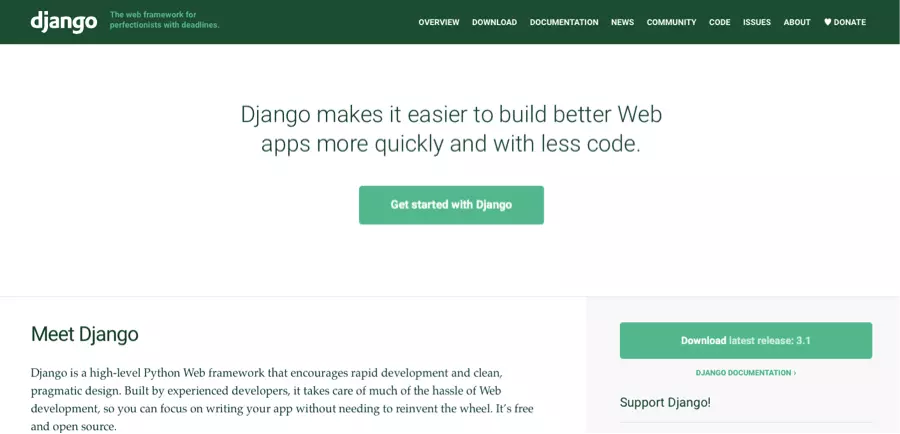
Django is an open-source Python web framework that follows a model-view-controller (MVC) architectural pattern, which separates the application’s logic, presentation, and data into separate components.
It was initially created in 2005 and has since become one of the most popular web frameworks for Python. Django primarily focuses on speed, simplicity, and ease of use.
Renowned websites such as Disqus, Mozilla, and The Washington Times have all implemented Django, solidifying its status as one of the best backend frameworks on the market.
Advantages Of Django
Django has several advantages that make it a popular choice for web development:
- It’s easy to learn and requires less code to build an application as compared to other web frameworks.
- Django follows the DRY (Don’t Repeat Yourself) principle, allowing developers to write code once and reuse it multiple times.
- It provides fast development as it comes with built-in features such as an ORM that makes database management easy.
- Django’s large and active community continuously contributes to its development, bug fixing, and documentation.
Limitations Of Django
As with any framework, Django has limitations.
- Django may not be the best option for building highly customized web applications. The framework is opinionated in how it structures your code, which may limit developers’ control over the code.
- Django is slower than some other web frameworks.
- The learning curve may be steep for beginners.
Features Of Django
- Object-relational mapping (ORM): This feature provides developers with an easy way to communicate with the database by allowing them to use Python objects instead of SQL queries. The ORM handles creating and managing the database schema, making the interaction between the database and the application hassle-free.
- Django admin: This built-in administrative interface comes with Django, saving developers the time and effort of building an admin panel. The intuitive interface allows developers to manage the application’s data through a user-friendly dashboard without writing code.
- URL handling: Django’s flexible URL routing system enables developers to create human-readable URLs and map them to the corresponding views. This feature allows users to navigate the application more easily and helps developers create SEO-friendly URLs.
- Built-in security features: Security is a significant concern in web development, and Django understands this concern. Django has integrated security features like cross-site request forgery protection, SQL injection protection, and password hashing, making it more secure and reliable for web application building purposes.
- Scalability: Django is highly scalable and offers various methods for scaling web applications. It can handle heavy traffic loads, making it perfect for large-scale web applications. Django also has an automatic caching mechanism that helps reduce the application’s response time. Additionally, it allows horizontal scaling by deploying the web application on multiple servers.
If you’re looking for a hassle-free way to deploy your Django application, Back4app Containers is an excellent option. Back4app backend platform provides a managed cloud service that can deploy your Python applications to the cloud in minutes.
Please read the Step-by-step tutorial to deploy a Django app in minutes to run easily your application.
In addition, with Back4app Containers, you can quickly scale your application’s capacity as demand grows, making it an excellent option for businesses looking to grow without worrying about infrastructure management.
Please read the article Top 10 Python Frameworks to learn more about Django.
ExpressJS
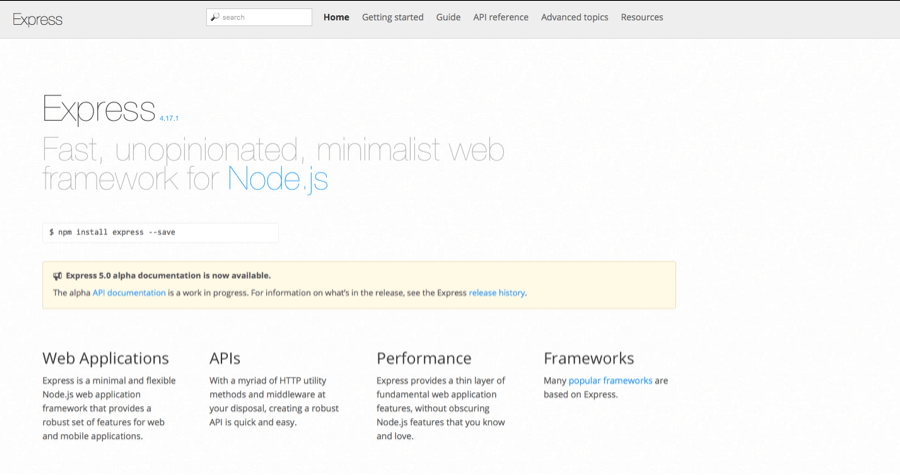
ExpressJS is a fast, lightweight, and flexible web application framework based on Node.js. It provides a distinctive set of features for web and mobile applications.
ExpressJS simplifies the development of server-side web applications, allowing developers to create dynamic web pages and APIs with ease. It comes with a powerful routing mechanism, middleware support, and numerous HTTP utility methods to handle requests and responses.
ExpressJS provides a way to organize code and applications in a more modular way by allowing developers to use third-party libraries and packages that serve as plugins. This makes the development process faster, more efficient, and less prone to errors.
Advantages of ExpressJS
- ExpressJS is a popular framework of Node.js, which means there is good community support and easy-to-find help online.
- It provides a powerful routing module that helps in creating complex routes for web applications.
- Middleware support enables easy integration with other third-party libraries.
- An easy way to handle requests and responses to and from servers using a RESTful API.
- It is flexible and customizable, allowing developers to write clean and efficient code.
- ExpressJS provides a robust toolset for error handling and debugging, making the development process more manageable.
Limitations of Express JS
- As a backend-only framework, ExpressJS is not designed for building rich user interfaces or interactive client-side components.
- It requires developers to have a good understanding of Node.js before diving into the framework.
- ExpressJS has several security issues that developers need to address on their own, such as cross-site scripting (XSS) and injection attacks.
- With no built-in ORM, developers need to use third-party libraries to manage databases.
Features Of Express JS
- Routing: Express JS has a powerful routing system that allows developers to easily map HTTP requests to specific controllers or functions. This makes it easy to create dynamic web applications that can respond to user input in real time.
- Middleware: One of the standout features of Express JS is its middleware architecture, which enables users to add custom functions or plugins to the application pipeline. This enables developers to easily manage requests and responses, as well as add authentication, compression, and other functionality to their apps.
- Templating Language: Express JS also supports a number of popular templating languages, such as Pug, EJS, and Handlebars. This makes it easy for developers to create dynamic web pages that can be updated in real-time without refreshing the entire page.
- Error Handling: With Express JS, developers have access to a robust error-handling system that allows them to catch and handle errors in a graceful manner. This makes it easier to debug and troubleshoot issues as they arise and ensures a better end-user experience.
- Scalability: Finally, Express JS is known for its scalability and performance, making it a popular choice for building large-scale web applications. Its modular architecture allows developers to add or remove features as needed, and its lightweight design ensures that it can handle high levels of traffic and data without putting undue strain on servers or other resources.
How Do I Host An ExpressJS App?
When it comes to hosting your ExpressJS application, there are a couple of options to choose from. The first option is to build and operate your servers using large infrastructure providers such as AWS.
While this option requires more engineering effort to create and manage servers, it provides more flexibility and control over your servers.
If you’re looking for a quicker time to market and don’t want to deal with server management, the second option is to host your app using a BaaS (Backend as a Service) platform such as Back4App.
This fully managed service offers a straightforward approach to hosting your app, but it does offer less flexibility than running your own server.
Please refer to the tutorial Step-by-step guide to run a Node.JS app to deploy an application in minutes.
Please read the article Javascript Frameworks to know more about ExpressJS.
Laravel
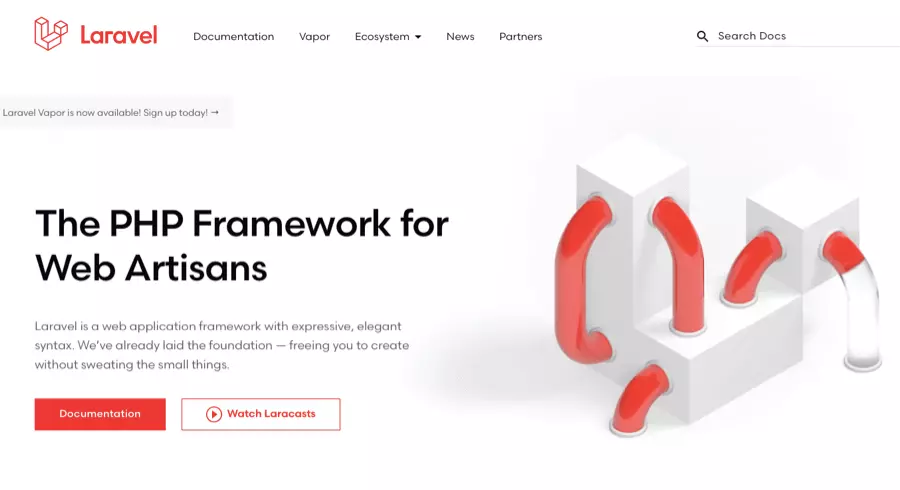
Laravel is a PHP, open-source web framework designed for developing web applications based on the Symfony framework.
It comes with a modular packaging system that includes a dedicated dependency manager. This technology is widely regarded as one of the top web frameworks and is considered the ideal software for backend development by many experts.
One of the most distinctive features of Laravel is its ability to provide several different ways of accessing relational databases while also offering utilities for application maintenance and deployment. Additionally, Laravel is equipped with an MIT license, and its source code is hosted on GitHub.
Please check out the tutorial Easy steps to run a Laravel app to learn how to deploy an application in minutes.
Advantages Of Laravel
- Open-source framework.
- Modular architecture for building scalable applications.
- Uses the MVC architectural pattern for clean and organized code
- It has Artisan, a built-in command-line interface.
- Provides an ORM system (Eloquent) and database migration tools.
- Includes a built-in authentication system for user login and registration.
Limitations Of Laravel
While Laravel is one of the best backend frameworks, it has some drawbacks.
- Slow development compared to other backend frameworks.
- Limited built-in support in comparison to rivals like Django and Ruby on Rails.
- Third-party tools are often required to overcome this limitation.
- Ambiguous updates can be risky and cause compatibility issues or security concerns.
- Developers need to take precautions when integrating new updates.
Features Of Laravel
- Easy routing: Laravel provides an easy-to-use routing system that allows developers to define routes for their applications with minimal effort. Developers can define routes using a simple syntax and take advantage of Laravel’s built-in route caching to improve the performance of their applications.
- Database migration: Laravel offers a powerful database migration system that allows developers to manage database schema changes using PHP code. This feature makes it easy for developers to change their database schema without manually updating it.
- Strong Template Engine: Laravel uses Blade, which provides valuable features such as template inheritance, sections, and layouts. Blade helps you to create reusable templates and avoid code duplication in your application.
- Elevated ORM: Laravel’s Eloquent ORM allows developers to work with databases using an object-oriented approach. This feature makes it simple to connect with other data sources and perform common database operations such as creating, reading, updating, and deleting records.
- Authentication: Laravel provides an easy-to-use authentication system that makes adding user registration, login, and logout functionality to your applications easy. The system is customizable and supports OAuth and LDAP authentication out-of-the-box.
- Security: Laravel includes several features to help secure your application, such as encrypted sessions and secure password hashing using bcrypt. The framework also provides easy-to-use APIs for implementing two-factor authentication and password resets.
If you want to learn more about Laravel, read our PHP Frameworks article.
Ruby on Rails
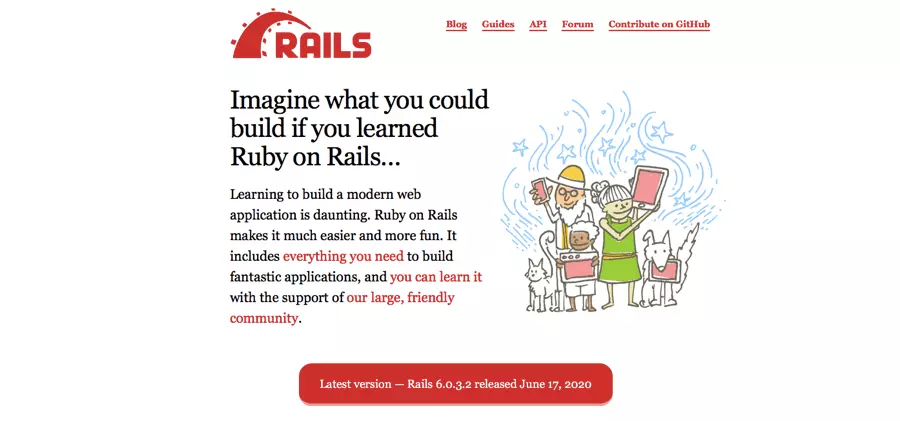
Ruby on Rails, also known as Rails, is a web application framework built on the Ruby programming language.
With its powerful tools, this platform empowers developers to create web applications that are modern and scalable. It prioritizes ease of use and convenience by providing default solutions for everyday problems. This way, developers can focus on creating features that are tailored to their applications’ unique needs.
Furthermore, this platform encourages the use of industry-standard technologies such as CSS, HTML, JavaScript, and JSON. It also adheres to software engineering patterns such as DRY (Don’t Repeat Yourself) and COC (convention over configuration), streamlining the development process and ensuring high-quality code.
Rails has been used for various applications, from small personal projects to large enterprise-level applications. Some developers even consider it the best-performing web framework, making it one of the most popular backend frameworks for web development.
Please check the tutorial Deploying a Ruby on Rails application to learn more how a serverless architecture helps developers in hosting applications.
Advantages Of Ruby On Rails
- Rails comes with tons of tools to make it easy and efficient to build web applications.
- Rails is well-suited for agile development methodologies, with its modular architecture and the ability to modify functionality as needed easily.
- Ruby on Rails has a large and active community, with many resources and tools available to help developers learn and troubleshoot.
- Rails is designed to be scalable, with the ability to easily add new functionality and scale up as needed.
- Rails comes with built-in testing functions, making it easy to test code and ensure functionality.
Limitations Of Ruby On Rails
- While Rails is great for rapid development, it can sometimes be slower than other frameworks when it comes to performance. Ruby on Rails can have a steep learning curve for those unfamiliar with the framework.
- Sometimes updates to one part of the Rails framework can cause issues with other parts of the framework, especially if developers are using older versions of Rails.
Features Of Ruby On Rails
- Model-View-Controller (MVC) architecture: Rails follows the MVC pattern, making it easy to separate a web application’s code into three distinct parts: the model (database), views (user interface), and controller (business logic).
- Convention over configuration: Rails makes many assumptions about how developers will structure their web application’s code, which saves time and effort in the development process.
- Scaffolding: Rails allows developers to quickly generate code for basic CRUD (Create, Read, Update, Delete) functionality using scaffolding.
- Active Record: Rails comes with an object-relational mapping (ORM) tool called Active Record, which makes it easy to interact with databases using Ruby code.
- Testing framework: Rails comes with built-in testing functions, such as unit tests and system tests, making it easy to ensure that the code is working as intended.
- Security features: Rails has several built-in security features, such as protection against cross-site scripting (XSS) and cross-site request forgery (CSRF) attacks.
Ruby on Rails Features
MVC Architecture – Ruby on Rails is MVC-based, one of the most widely used web application architectures globally. Developers who are already experienced in working with MVC patterns can quickly start using Ruby on Rails. This architecture separates codes by their functions i.e., data layer, presentation layer, and maintaining a resource layer.
Active Record – Ruby on Rails relies on a library known as an active record, enabling developers to perform database interaction query design effortlessly. Queries are written on the Ruby programming language and converted into SQL queries that receive outputs and return objects. The Ruby on Rails active record library is quite capable, and the need for developing a query in SQL is reduced.
Convention over Configuration – Configuration files are not utilized by Ruby on Rails as it provides dynamic runtime extensions, reflections, and conventions. It follows a “Convention over Configuration” approach for automatically assigning value without requiring user intervention. Multiple configuration files are utilized by software systems like Java web application frameworks, with each having multiple settings. Convention raises productivity as users are not required to assign time for config file setup.
Testing is simple – Ruby on Rails offers RSpec, an easy-to-use unit testing setup. Users can easily test functions through separate calls and make sure that an application undergoes adequate testing.
Please read the article Ruby Frameworks to know more about Ruby on Rails.
CakePHP
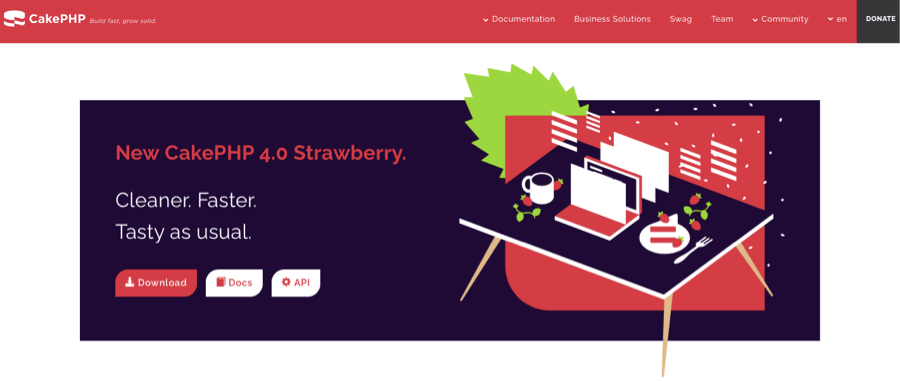
CakePHP is a popular open-source web framework widely used for creating robust and scalable web applications. It is written in PHP and follows the Model-View-Controller (MVC) architectural pattern, which separates the application logic, presentation layer, and data processing.
The framework has been made available under an MIT license, allowing developers to use it freely to build web applications. Inspired by Ruby on Rails concepts, CakePHP employs key software design and engineering principles, including the front controller, active record, data mapping, and convention over configuration.
Its strong features, including scaffolding, baking, and security, make it one of the most used backend frameworks among developers for rapid and secure web development.
Please use the tutorial Deploying a CakePHP app in minutes to know more how to use containers to accelerate hosting.
CakePHP Advantages
- MVC Architecture separates the application into three distinct components for easier maintenance and scalability.
- Object-Relational Mapping (ORM) allows developers to interact with databases using PHP code, for a faster and less error-prone development process.
- CakePHP features a code generation tool that automates CRUD operations for database tables, saving time and effort.
- Provides built-in tools and plugins for authentication, authorization, and security. This makes the application more secure, protects against threats such as CSRF (Cross-Site Request Forgery), and ensures user privacy and confidentiality.
CakePHP Limitations
- There is a steep learning curve, especially for new developers unfamiliar with MVC architecture or ORM systems.
- The performance of CakePHP can be slower than other web application frameworks, especially for large datasets or complex applications, affecting overall performance and scalability.
- It can be challenging to find help for bugs or issues since its customer service is not as extensive and reliable as other frameworks.
CakePHP Features
- Routing: CakePHP provides a powerful routing system that allows developers to define custom URLs for their applications. This makes the application more user-friendly and SEO-friendly.
- Caching: CakePHP has built-in caching support that can help improve the application’s performance. This allows developers to store frequently accessed data in memory or disk to reduce the number of database queries.
- Templating: CakePHP has a built-in templating engine that enables developers to define templates for their applications. This makes the application more manageable, allows for easier maintenance, and simplifies the design process.
- Community-driven development: CakePHP is a community-driven development framework that is actively maintained and updated by a large team of developers. This ensures that the framework continuously evolves and new features and improvements are regularly added.
Keep reading to learn more about the best server side frameworks available in the market.
Flask

Flask is a small-scale web framework that was developed using the Python programming language. It is lightweight and straightforward, making it easy for developers to create web applications quickly without imposing any specific libraries or tools.
Flask provides everything necessary to develop web applications without requiring any other particular tools. It is highly customizable and scalable, and complements a wide range of libraries and tools.
Flask’s feature set includes URL routing, templating, HTTP request handling, and tools for testing, debugging, and profiling web applications. Flask also has detailed documentation, making it easy for developers to learn and start building powerful web applications.
The tutorial A step-by-step guide to run and deploy a Flask application describes in detail the process of running a Flask application.
Advantages of Flask
- Lightweight, simple, and easy to use
- Provides necessary tools without imposing specific libraries or tools
- Quick to set up, requiring minimal time and resources to start building applications
- Highly customizable, allowing developers to tailor applications based on specific requirements
- Offers flexibility, scalability and complements a wide range of libraries and tools
- Allows incorporation of third-party extensions without affecting performance
- Comprehensive documentation that is easily accessible and provides detailed guidance on using the framework
- Enables developers to quickly learn and start building powerful web applications.
Limitations of Flask
- Flask is a micro-framework and lacks certain typical features found in full-stack web frameworks
- Features such as user authentication, user authorization, and access control are not included in Flask
- Developers need to rely on third-party libraries to implement these features
- This may increase the complexity of the application and add an additional layer of administration and security.
Features of Flask
Flask offers some unique features that make it suitable for various web application development projects. The following are some of the main features of Flask.
- URL routing: Flask provides support for URL routing. This routing mechanism maps a user’s requests to the appropriate view functions that are responsible for rendering the corresponding response based on the request method.
- Templating: Flask comes with Jinja2, a templating engine that allows the easy separation of business logic and presentation. This facilitates the creation of reusable and modular web components.
- HTTP request handling: Flask uses Werkzeug, a WSGI toolkit, to handle HTTP requests. This ensures reliable and secure request handling, which is essential for scalable and robust web applications.
- Web development: Flask also provides support for seamless web development. This includes tools for testing, debugging, and profiling web applications. These tools help developers to write more efficient and reliable code.
ASP .NET Core
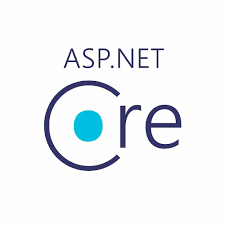
ASP.NET Core is an open-source web application framework developed by Microsoft. It is a cross-platform framework that enables developers to build high-performance and scalable web applications for multiple platforms, including Windows, macOS, and Linux.
ASP.NET Core was created on top of the .NET Core runtime, which is optimized for cloud computing. It offers a modular architecture with built-in security features, cloud readiness, and cross-platform development capabilities. ASP .NET Core provides numerous features that make it easy for developers to build maintainable, scalable, and performant web applications using a single codebase.
ASP.NET Core Advantages
- The cross-platform framework supporting multiple operating systems
- ASP.NET Core is optimized for high performance with improved scalability and better runtime performance
- The modular architecture or ASP.NET Core utilizes smaller and more focused NuGet packages for reusability, maintainability, and scalability.
- Cloud-ready with built-in support for cloud development and deployment, including cloud-based configuration management, distributed caching, and automated scalability
- Built-in security features for secure web applications, including support for HTTPS, authorization, authentication, and data protection.
ASP.NET Core Limitations
- Steep learning curve compared to other web frameworks
- Requires knowledge of C#, .NET Framework, and programming paradigms such as MVC and API design
- The tool set of ASP.NET Core still requires improvements for more robust and feature-rich development.
ASP.NET Core Features
- Cross-platform development: ASP.NET Core provides cross-platform development capabilities for developing web applications that can be deployed on multiple operating systems.
- Scalability: ASP.NET Core is highly scalable, enabling developers to build applications that can handle large volumes of traffic without performance degradation.
- Caching: ASP.NET Core provides built-in support for caching, making it easier for developers to improve application performance by reducing the number of round-trip requests to the database.
- Advanced routing: ASP.NET Core allows developers to create complex URL routing patterns and enables pattern matching to distinguish between different route types.
- Built-in dependency injection: ASP.NET Core comes with built-in dependency injection support, which makes it easier for developers to build loosely coupled and maintainable applications.
Spring Boot

SpringBoot is an open-source Java-based framework that builds upon the popular Spring framework. It was created to make the process of building, deploying, and running standalone and web-based applications easier.
SpringBoot is built on the principles of convention over configuration, which means that developers can focus more on writing business logic instead of spending time on setup.
One of the benefits of SpringBoot is the ability to easily create microservices. Microservices are a popular architectural pattern used to build complex systems that are composed of independent and autonomous services that communicate with each other via APIs.
SpringBoot provides features such as fast startup times, embedded servers, and an opinionated approach to configuration, which make it an excellent choice for building robust and scalable microservices.
SpringBoot Advantages
- Rapid application development allows for the fast and easy creation of production-ready applications.
- Auto-configuration helps save developers time by automatically configuring required dependencies.
- Embedded servers simplify deployment by allowing developers to package their applications as executable JAR or WAR files.
- Provides a set of defaults and conventions, which reduces the number of decisions that developers need to make when building applications.
- Easy integration with other popular libraries and frameworks: such as Hibernate, Kafka, and Spring Data.
SpringBoot Limitations
- Since SpringBoot is built on top of the Spring framework, it can add additional complexity to developers who are new to Spring.
- While the opinionated approach can save time, it can also limit flexibility in terms of design choices.
- Steep learning curve. Having a good understanding of the Spring framework is required to effectively use SpringBoot.
- Since SpringBoot uses embedded servers, it can consume more memory than traditional application servers.
SpringBoot Features
- Auto-configuration: One of the standout features of SpringBoot is its automatic configuration capabilities. It can automatically configure components based on classpath settings, saving developers valuable time and reducing the amount of code they need to write.
- Actuator: SpringBoot provides endpoints that allow developers to monitor and manage their applications. The endpoints cover important areas like health, metrics, and shutdown. Developers can leverage these endpoints to easily gain insights into the performance of their applications, identify bottlenecks, and troubleshoot issues.
- Embedded servers: SpringBoot comes with embedded servers that simplify the deployment of applications. These servers, such as Tomcat, Jetty, and Undertow, make it easy for developers to deploy their applications to standalone or embedded servers. Developers can package their applications as executable JAR or WAR files, which makes deployment and distribution a breeze.
- Developer tools: SpringBoot provides developers with a range of handy developer tools to make their lives easier. These tools include automatic restarts, live reloading, and remote debugging. With these features, developers can more easily work collaboratively, get faster feedback on their changes, and improve productivity.
Koa
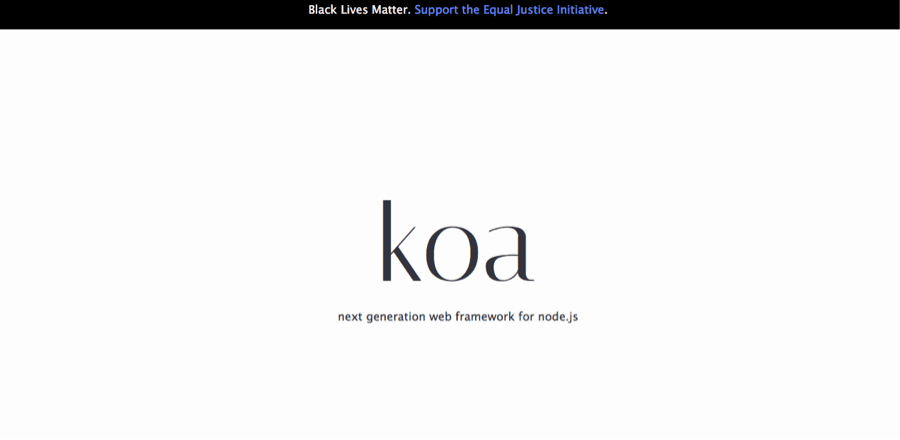
Koa is a web framework designed to be lightweight and expressive. It uses modern JavaScript features and allows developers to write middleware in a more concise and elegant way.
Koa provides a simpler and more efficient way to handle HTTP requests and responses, making it easier to build web applications and APIs. With its modular design and excellent error handling, Koa is a great choice for building modern and scalable web applications.
Advantages Of Koa
- Smaller in size and lighter in weight compared to Express, making it more performant.
- It uses a newer version of Node.js and, thus, has better support for asynchronous code that can handle more requests simultaneously, resulting in better scalability.
- Has a cleaner code structure compared to Express, making it easier to read and maintain.
- Middleware functions use a more modular composition model, making it easier to reuse code across multiple projects.
- Better error-handling support, making it easier to debug and find errors in production.
- Built-in request and response object that simplifies the process of handling HTTP requests and responses.
Limitations Of Koa
- Koa has a steeper learning curve compared to some other Node.js frameworks, especially for developers who are less experienced with JavaScript or functional programming concepts.
- The framework relies heavily on middleware functions, which can make the codebase more complex and harder to maintain in the long run.
- Koa does not include a built-in database or ORM support, which means developers will need to use external libraries or write custom code to handle database operations.
Features Of Koa
- Flexible middleware functions: Koa uses middleware functions for handling requests and responses. However, unlike other web frameworks that use a linear sequence of middleware, Koa allows for more flexible and versatile middleware. This is because Koa uses async/await, which allows for a more complex control flow and better error handling.
- Streamlined error handling: Error handling is an important part of any web application, and Koa makes it easier to handle and propagate errors. Koa uses try/catch statements to catch errors during middleware execution, which makes it possible to handle errors effectively and prevent them from crashing your Node.js server.
- Modular design and small codebase: Koa is a minimalist web framework that prioritizes simplicity and flexibility. Its small codebase and modular design make it easy to customize and add new features to your application. Because it is based on a middleware architecture, different functions can be added or removed as needed. This also makes Koa easier to learn and use for developers who are familiar with Node.js basics.
Phoenix

Phoenix is a modern web framework written in Elixir, a high-performance and scalable programming language. It is designed to make building and deploying web applications easier and faster.
Phoenix is inspired by many popular web frameworks like Ruby on Rails and Django, but it offers unique advantages that make it an ideal choice for developers.
Advantages Of Phoenix
- Phoenix framework is built on the Elixir programming language, which is known for its speed and scalability.
- Phoenix uses the Erlang virtual machine, making it highly reliable and fault-tolerant.
- It has built-in support for web sockets, making real-time applications easier to develop.
- Phoenix has a low memory footprint, which means it can take care of a large number of concurrent connections without sacrificing performance.
- It has a dedicated built-in testing framework, making it easier to write and run tests.
- Phoenix leverages the power of the OTP (Open Telecom Platform) library, providing powerful asynchronous processing capabilities.
Limitations Of Phoenix
- Phoenix is primarily a server-side web application framework, and while it does offer some client-side functionality through Phoenix LiveView, it may not be as robust as dedicated client-side frameworks like React or Vue.js.
- Phoenix is a relatively new technology, and developers may find it challenging to learn these technologies without prior experience in functional programming or the Erlang VM.
- While Phoenix is gaining in popularity, it is still a relatively niche technology, which means that there may be limited third-party libraries or packages available as compared to more established web frameworks like Ruby on Rails or Django.
- Developers coming from object-oriented programming languages may find the functional programming paradigm of Elixir and Phoenix difficult to grasp initially.
Features Of Phoenix
- Fast and scalable: Phoenix provides high performance and scalability thanks to its lightweight processes and advanced caching mechanisms.
- Real-time functionality: Phoenix offers real-time functionality out-of-the-box, with Channels allowing for bidirectional communication between clients and servers over WebSockets.
- Easy to use: Phoenix is built with productivity in mind, providing a clear and concise syntax to reduce boilerplate and make development easier.
- Built for modern web technologies: Phoenix leverages the latest web technologies, such as Elixir, Erlang’s VM, and JavaScript frameworks like React or Vue, to build robust and interactive web applications.
- Secure by design: Phoenix incorporates features like CSRF protection, input validation, and session management to ensure the security of your application without compromising on performance or ease of use.
Conclusion
You’re one step closer to unleashing the full potential of your next software project! Armed with the knowledge of the top backend languages and frameworks available today on the market, including big names like Django, Laravel, and Ruby on Rails, you’re equipped to make the best decision for your needs.
Make sure to consider the advantages and limitations of each framework before making a final decision, as well as the features they provide. Additionally, remember to think about how you’ll host your backend application once it’s created.
But don’t stop there—reach out to an experienced software consultant to take your project to the next level with their expert insight and guidance. The sky’s the limit! Additionally, if you want to improve your productivity when developing backends, we’ve got the answers you need. Dive deeper into our article about Backend as a Service – BaaS and discover how.
FAQ
What is a backend framework?
A software framework is a foundation where developers can make applications is a faster and standardized way.
Why use a backend framework?
– Time-Saving
– Scalability
– Robustness
– Security
– Integrations
What are the best 10 backend frameworks?
– Django
– Laravel
– Ruby on Rails
– ExpressJS
– CakePHP
– Flask
– Asp .NET
– Spring Boot
– Koa
– Phoenix
Which backend framework is most popular?
Recent surveys have shown that Laravel is the most popular backend framework as per its usage statistics. However, Django, another popular backend web framework, is catching up and closely following in second place.





